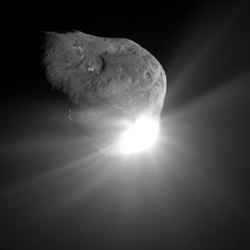
Deep Impact. Image credit: NASA. Click to enlarge
When Deep Impact collided with Tempel 1, it released an amazing amount of water vapour from the comet – as much as 250,000 tonnes were blasted into space. These measurements were made by NASA’s Swift satellite, which normally locates and observes gamma ray bursts. Swift, like almost every other telescope on Earth and in space was pointed at Comet Tempel 1 when Deep Impact smashed into it last July. Swift monitored the X-ray emissions before and after the collision, and used that to measure the amount of water vapour ejected.
Over the weekend of 9-10 July 2005 a team of UK and US scientists, led by Dr. Dick Willingale of the University of Leicester, used NASA’s Swift satellite to observe the collision of NASA’s Deep Impact spacecraft with comet Tempel 1. Reporting today (Tuesday) at the UK 2006 National Astronomy Meeting in Leicester, Dr. Willingale revealed that the Swift observations show that the comet grew brighter and brighter in X-ray light after the impact, with the X-ray outburst lasting a total of 12 days.
“The Swift observations reveal that far more water was liberated and over a longer period than previously claimed,” said Dick Willingale.
Swift spends most of its time studying objects in the distant Universe, but its agility allows it to observe many objects per orbit. Dr. Willingale used Swift to monitor the X-ray emission from comet Tempel 1 before and after the collision with the Deep Impact probe.
The X-rays provide a direct measurement of how much material was kicked up after the impact. This is because the X-rays were created by the newly liberated water as it was lifted into the comet’s thin atmosphere and illuminated by the high-energy solar wind from the Sun.
“The more material liberated, the more X-rays are produced,” explained Dr. Paul O’Brien, also from the University of Leicester.
The X-ray power output depends on both the water production rate from the comet and the flux of subatomic particles streaming out of the Sun as the solar wind. Using data from the ACE satellite, which constantly monitors the solar wind, the Swift team managed to calculate the solar wind flux at the comet during the X-ray outburst. This enabled them to disentangle the two components responsible for the X-ray emission.
Tempel 1 is usually a rather dim, weak comet with a water production rate of 16,000 tonnes per day. However, after the Deep Impact probe hit the comet this rate increased to 40,000 tonnes per day over the period 5-10 days after impact. Over the duration of the outburst, the total mass of water released by the impact was 250,000 tonnes.
One objective of the Deep Impact mission was to determine what causes cometary outbursts. A simple theory suggests that such outbursts are caused by the impact of meteorites on the comet nucleus. If this is the case, Deep Impact should have initiated an outburst.
Although the impact was observed across the electromagnetic spectrum, most of what was seen was directly attributable to the impact explosion. After 5 days, optical observations showed that the comet was indistinguishable from its state prior to the collision. This was in stark contrast to the X-ray observations.
The analysis of the X-ray behaviour by the Swift team indicates that the collision produced an extended X-ray outburst largely because the amount of water produced by the comet had increased.
“A collision such as Deep Impact can cause an outburst, but apparently something rather different from the norm can also happen,” said Dr. Willingale. “Most of the water seen in X-rays came out slowly, possibly in the form of ice-covered dust grains.”
Original Source: RAS News Release
